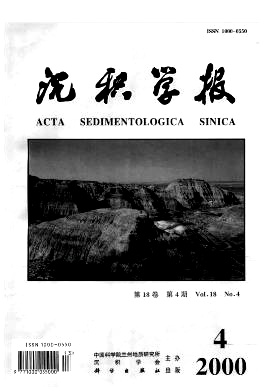|
[1]
|
Beynon B M, Pemberton S G, Bell D A et al. Environmerntal implications of ichnofossils fron the Lower Cretaceous Grand Rapids Formation, Cold Lake Oil Sands Deposit. In: James D J, Leckie D A, eds., Sequences, Stratigraphy, Sedimentology: Surface and Subsurface[C]. Canadian Society of Petroleum Geologists Memoir, 1988,15:275~90 |
|
[2]
|
Bromley R G, Asgaard U. Ichnofacies: A mixture of taphofacies and biofades[J]. Lethaia, 1991,24:153~63 |
|
[3]
|
Bromley R G,Ekdale A A. Chondrites: A trace fossil indicator of anoxia in sediments[J]. Science, 1984,224:872~74 |
|
[4]
|
Cotter E, Graham J R. Coastal plain sedimentation in the late Devonian of southern Ireland; hummocky cross-stratigication in fluvial deposits [J]. Sedimentary Geology, 1991,72:201~24 |
|
[5]
|
Dam G. Paleoenvironmental significance of trace fossils from the shallow marine Lower Jurassic Neill Klinter Formation, East Greenland [J]. Palaeogeogr. Palaeoclimatol. Palaeoecol., 1990,79:221~48 |
|
[6]
|
Dott H R Jr. 1982 SEPM Presidential address: Episodic sedimentation: How normal is average? How rare is rare? Does it matter? [J]. Journal of Sedimentary Petrology, 1983,53:5~23 |
|
[7]
|
Dott R H Jr, Bourgeois J. Hummocky stratification: Significance of its variable bedding sequences[J]. Geological Society of America Bulletin, 1982,93:663~ 80 |
|
[8]
|
Duke W L. Hurmmocky cross-stratification, tropical hurricanes, and intense winter storms[J]. Sedimentology, 1985,32:167~94 |
|
[9]
|
Duke W L. Geostrophic circulation or shallow marine turbidity currents? The dilemma of paleoflow patterns in storm-induced prograding shoreline systems[J]. Journal of Sedimentary Petrology, 1990,60:870 ~83 |
|
[10]
|
Duke W L, Amott R W C, Cheel R J. Shelf sandstones and hummocky cross-stratification: New insights on a storm debate[J]. Geology, 1991,19:625~28 |
|
[11]
|
Ekdale A A. Paleoecology of marind endobenthos[J]. Palaeogeogr., Palaeoclimatol., Palaeoecol., 1985,50:63~81 |
|
[12]
|
Follrni K B, Grimm K A. Doomed pioneers: Gravity-flow deposition and bioturbation in marine oxygen-deficient environments[J]. Geology, 1990,18:1069~72 |
|
[13]
|
Frey R W. Trace fossils and huammocky cross-stratification, Upper Cretaceous of Utah [J]. Palaios, 1990,5:203 ~ 18 |
|
[14]
|
Frey R W,Goldring R. Marine event beds and recolonization surfaces as revealed by trace fossil analysis[J]. Geological Magazine, 1992, 129:325~35 |
|
[15]
|
Grimm K A,Follmi K B. Doomed pioneers: Event deposition and bioturbation in anaerobic environments [J]. American Association of Petroleum Geologists Bulletin, 1990,74:666 |
|
[16]
|
Harms J C. Primary sedimentary structures[J]. Annual Review of Earth and Planetary Science, 1979,7:227~48 |
|
[17]
|
Hayes M O. Hurricanes as geological agents: Case studies of Hurricanes Carla, 1961 and Cindy, 1963[R]. Bureau of Economic Geology, The University of Texas, Report of Investigations, 1967,61:1 ~56 |
|
[18]
|
Hunter R E,Clifton H E. Cyclic deposits and hummocky cross- stratification of probable storm origin in Upper Cretaceous rocks of the Cape Sebastian area, southwestern Oregon[J]. Journal of Sedimentary Petrology, 1982,52:127 ~43 |
|
[19]
|
Johnston H D,Baldwin C T. Shallow siliciclastic seas. In: Reading H G ed., Sedimentary Facies and Environments [M]. 2d ed, Oxford: Blackwell Scientific Publications, 1986,229~82 |
|
[20]
|
Leckie D A, Krystinik L A. Is there evidence for geostrophic currents preserved in the sedimentary record of inner to middle-shelf deposits? [J]. Journal of Sedimentary Petrology, 1989,59:862 ~ 70 |
|
[21]
|
Leckie D A,Walker R G. Storm-and tide-dominated shorelines in Cretaceous Moosebar-Lower Gates interval-outcrop equivalents of deep basin gas trap in Western Canada[J]. Bulletin of American Association of Petroleum Geologists, 1982,66:138~ 57 |
|
[22]
|
Levinton J S. The paleoecological significance of opportunistic species [J]. Lethaia, 1970,3:69~78 |
|
[23]
|
Morton R A. Nearchore responses to great storms[A]. Geological Society of America Special Paper, 1988,229: 7~ 22 |
|
[24]
|
Morton R A, Paine J G. Beach and vegetation line changes at Galveston Island Texas; Erosion, deposition, and recovery from Hurricane Alicia[J]. The University of Texas at Austin Bureau of Economic Geology, Geological Circular, 1985,85~5:1 ~39 |
|
[25]
|
Pemberton S G,Frey R W. Ichnology of storm-influenced shallow rmarine sequence: Cardium Formation (Upper Cretaceous) at Seebe, Alberta[A]. In: Stott D F, Glass D J, eds. The Mesozoic of Middle North America[C]. Canadian Society of Petroleum Geologists Memoir, 1984,9: 281 ~ 304 |
|
[26]
|
Pemberton S G, Van Wagoner J C, Wach G D. Ichnofacies of a wavedominated shoreline[A]. In: Pemberton S G ed., Application of Ichnology to Petroleum Exploration[C]. Society of Economic Paleontologists and Mineralogists, Core Workshop, 1992,17:339~82 |
|
[27]
|
Seilather A. Paleontological studies in turbidite sedimentation and erosion[J]. Journal of Geology, 1962,70: 227~ 34 |
|
[28]
|
Seilacher A. General remarks about event beds[A]. In: Einsele G,D, Seilacher A,eds. Cyclic and Event Stratification[C]. Berlin: SpringerVerlag, 1982.161 ~ 74 |
|
[29]
|
Vossler S M, Pemberton S G. Skolithos in the Upper Cretaceous Cardium Formation: An ichnofossil example of opportunistic ecology[J]. Lethaia, 1988,21:351 ~62 |
|
[30]
|
Vossler S M. Ichnology and paleoecology of offshore siliciclastic deposits in the Cardium Formation (Turonian, Alberta, Canada) [J]. Palaeogeogr., Palaeoclimatol., Palaeoeeol.,1989,74:217~29 |
|
[31]
|
Walker R G. Shelf and shallow marine sands[A]. In: Walker R G, ed. Facies Models[C], 2d ed., Reprint Series 1, Toronto: Geoscience Canada, 1984.141~70 |
|
[32]
|
Walker R G. Turbidites and associated coarse clastic deposits[A]. In: Walker R G,ed. Facies Models[C]. 2d ed., Reprint Series 1, Toronto: Geoscience Canada, 1984.171 ~88 |
|
[33]
|
Zhou Zhicheng, Li Yue, Pemberton S G. Upper Cambrian trace fossils from eastern North China Platform and their environmental significance (in Press) |






 DownLoad:
DownLoad: